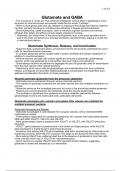Class notes
Chapter 8: Glutamate and GABA
- Course
- Institution
- Book
Chapter 8 provides an extensive overview of the roles of the neurotransmitters glutamate and GABA in the central nervous system. It delves into these neurotransmitters' synthesis, release, and inactivation processes, emphasizing their critical functions in excitatory and inhibitory neural transmiss...
[Show more]



